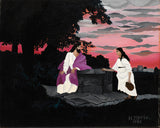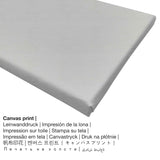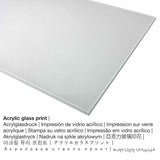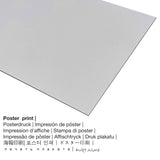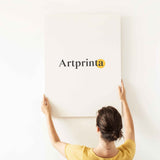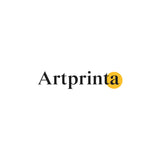Horace Pippin, 1940 - Kraịst na Nwanyị Sameria - mbipụta nka mara mma
Ụtụ gụnyere. Mbupu gbakọrọ na ndenye ọpụpụ.
Nkọwapụta ngwaahịa nka
In 1940 Horace Pippin painted the piece of art. The over 80 years old original was made with the size: N'ozuzu: 19 3/4 x 24 1/4 na (50,2 x 61,6 cm) e were kwa ihe-ọcha tee ya mmanụ na kwaaji. N'ịga n'ihu, enwere ike ilele ihe nka n'ime Ụlọ ọrụ Barnes Foundation nchịkọta dijitalụ. Nke nkà nke oge a public domain piece of art is provided with courtesy of Courtesy of the Barnes Foundation, Merion and Philadelphia, Pennsylvania.The creditline of the artpiece is: . On top of that, alignment of the digital reproduction is odida obodo ma nwee oke akụkụ nke 1.2: 1, nke pụtara na ogologo bụ 20% ogologo karịa obosara.
Họrọ ngwa ngwaahịa ịchọrọ ịnwe
In the dropdown lists next to the article you can choose the size and material of your choice. Select your preferred size and material among the following alternatives:
- Metal (aluminium debond mbipụta): Aluminium Dibond prints are metal prints with a true depth - for a modern look and non-reflective surface structure. Colors are luminous in the highest definition, the details of the print are crisp and clear. The print on aluminium is one of the most popular entry-level products and is a truly modern way to display fine art prints, as it puts 100% of the viewer’s attention on the artwork.
- Mbipụta iko acrylic (nke nwere ezigbo mkpuchi iko): An print on acrylic glass, which is sometimes described as a UV print on plexiglass, will turn your favorite original artwork into décor and offers a viable alternative option to dibond and canvas prints. Your work of art is being custom-made with state-of-the-art UV direct print technology. The major advantage of an acrylic glass fine art print is that contrasts as well as granular image details become exposed due to the subtle gradation.
- Bipụta akwụkwọ mmado n'ihe kwaaji: A poster print is a UV printed sheet of canvas with a slight structure on the surface. Please keep in mind, that depending on the absolute size of the canvas poster print we add a white margin of approximately 2 - 6cm round about the painting in order to facilitate the framing.
- Mbipụta kanvas: A printed canvas, which should not be mistaken with a painting on a canvas, is a digital copy printed from a UV direct printing machine. Canvas prints are relatively low in weight. This means, it is easy and straightforward to hang up your Canvas print without extra wall-mounts. A canvas print is suitable for any kind of wall in your house.
Ihe dị mkpa: We try what we can to describe the art products as clearly as possible and to showcase them visually. Nonetheless, the pigments of the printed materials and the printing may vary slightly from the image on your monitor. Depending on the settings of your screen and the nature of the surface, not all color pigments are printed 100% realistically. Bearing in mind that the are processed and printed by hand, there might also be minor deviations in the exact position and the size of the motif.
Nkọwa ihe ahaziri ahazi
| Nkewa ngwaahịa: | ọmarịcha nka |
| Usoro mmeputakwa: | dijitalụ mmeputakwa |
| Production usoro: | Mbipụta UV / dijitalụ |
| Ihe ngosi: | German mere |
| Stockdị ngwaahịa: | mmepụta ihe na-achọ |
| Ihe eji eme atụmatụ: | foto mgbidi, gallery mgbidi |
| Nhazi onyonyo: | nhazi odida obodo |
| Ụdị anya: | 1.2: 1 (ogologo: obosara) |
| Mmetụta nke akụkụ akụkụ: | ogologo bụ 20% ogologo karịa obosara |
| Nhọrọ akụrụngwa: | ígwè ebipụta (aluminium dibond), acrylic glass print (nwere ezigbo mkpuchi iko), mbipụta akwa akwa, mbipụta akwụkwọ mmado (akwụkwọ kwaaji) |
| Canvas dị n'elu ihe nrịbama (mbipụta kanvas) nha dị iche iche: | 60x50cm - 24x20", 120x100cm - 47x39", 180x150cm - 71x59" |
| Mpempe iko acrylic (nwere ezigbo mkpuchi iko) nha: | 60x50cm - 24x20", 120x100cm - 47x39", 180x150cm - 71x59" |
| Ụdị akwụkwọ mmado (akwụkwọ kwaaji) dị iche iche: | 60x50cm - 24x20", 120x100cm - 47x39" |
| Mbipụta aluminom (ihe alumini debond ihe): | 60x50cm - 24x20", 120x100cm - 47x39" |
| Nhazi mmeputa nka nka: | adịghị |
Iberibe nkọwa nka
| Iberibe aha nka: | "Kraịst na Nwanyị Sameria" |
| nhazi ọkwa: | sere |
| Otu sara mbara: | nkà nke oge a |
| Time: | 20th narị afọ |
| Ekepụtara: | 1940 |
| Ogologo afọ nka nka: | karịa afọ 80 |
| Ihe osise izizi: | mmanụ na kwaaji |
| Ogo nke ọrụ nka izizi: | N'ozuzu: 19 3/4 x 24 1/4 na (50,2 x 61,6 cm) |
| Ụlọ ihe ngosi nka: | Ntọala Barnes |
| Ebe ngosi nka: | Philadelphia, Pennsylvania, Njikota Obodo Amerika |
| Ụlọ ihe ngosi nka ibe weebụ: | Ntọala Barnes |
| Ikikere nke ihe osise: | ngalaba ọha |
| Site n'aka: | Site n'ikike nke Barnes Foundation, Merion na Philadelphia, Pennsylvania |
Nchịkọta ihe nkiri
| Ihe nkiri: | Horace Pippin |
| A makwaara dịka: | pippin h., Pippin, Horace Pippin, Pippin Horace |
| Gender: | nwoke |
| Obodo onye nka: | American |
| Ọrụ nke onye na-ese ihe: | onye na-ese ihe |
| Country: | United States |
| Nhazi nke onye nka: | omenkà nke oge a |
| Nwụrụ anwụ: | 58 afọ |
| Afọ amụrụ: | 1888 |
| Amụrụ na (ebe): | West Chester, Chester County, Pennsylvania, Njikota Obodo Amerika |
| Afọ nwụrụ: | 1946 |
| Ebe ọnwụ: | West Chester, Chester County, Pennsylvania, Njikota Obodo Amerika |
Copyright right, Artprinta.com (Artprinta)
Additional artwork information by the museum's website (© Copyright - by Barnes Foundation - Ntọala Barnes)
The picture shocks by its drama, which is due primarily to Pippin's original use of color. The intense gradations of fuchsia and gray in the sky meet dramatically at the horizon with an intense purplish red against the green-blacks of the foliage. The placement of Christ's crisp, silhouetted purple cloak, firmly situated as if in a niche between the well and stones and the dark foliage behind, is a powerful color statement.Barnes believed that Pippin had been influenced by the composition of a painting formerly attributed to Tintoretto (Christ and the Woman of Samaria, BF823) of the same subject in the Foundation. The painting conceivably has another source rooted in African American experience, specifically, Pippin's deep religious faith. One of the fundamental aspects of Barnes's attraction to Pippin's work and his reference to its "counterparts in the Spirituals of the American Negro" was their shared love for the powerful emotions evoked by the simplicity, directness, and rhythms of that indigenous music. It is likely that Pippin, familiar with a wide repertoire of accompanied and a cappella songs, knew the traditional spiritual "Jesus Met the Woman at the Well". Richard J. Wattenmaker, American Paintings and Works on Paper in the Barnes Foundation (Merion, PA: The Barnes Foundation; New Haven: Yale University Press, 2010), 307-9.

